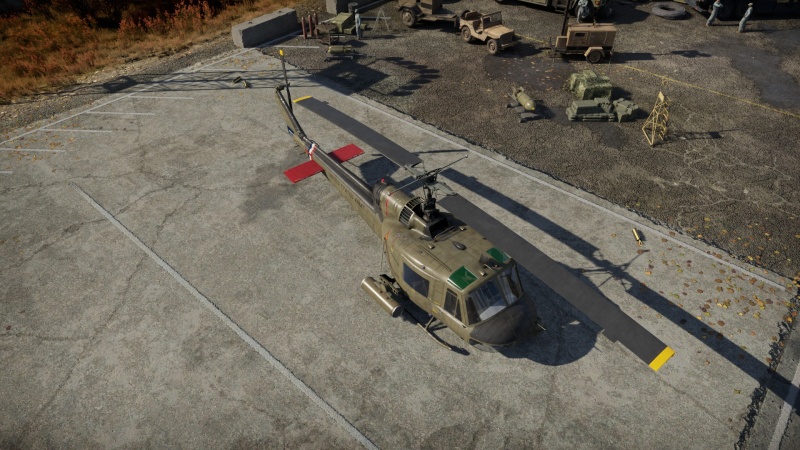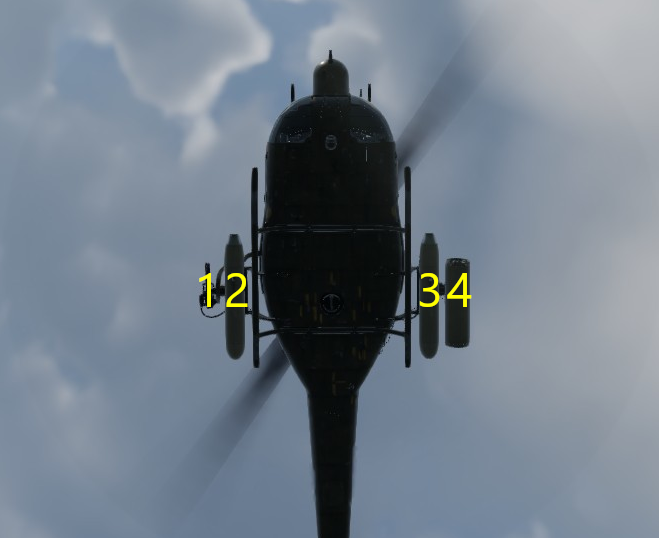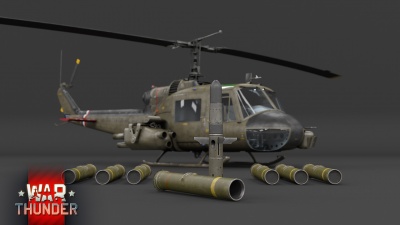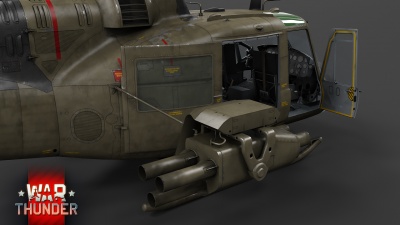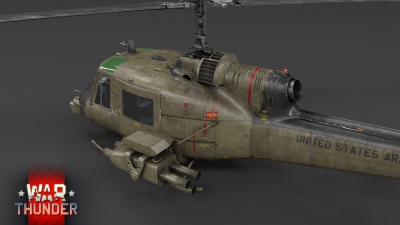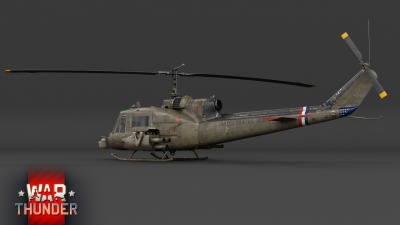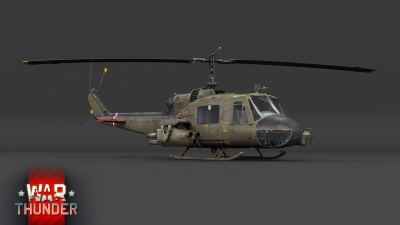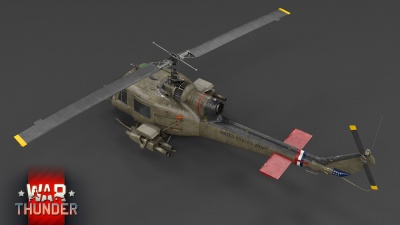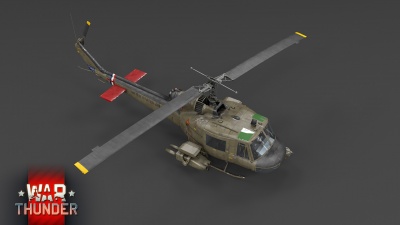UH-1C
| This page is about the American utility helicopter UH-1C. For other variants, see UH-1 (Family). |
Contents
Description
The UH-1C is a rank American utility helicopter with a battle rating of (AB), (RB), and (SB). It was introduced in Update 1.81 "The Valkyries".
General info
Flight performance
| Characteristics | Max Speed (km/h at 0 m - at sea level) |
Max altitude (metres) | |
|---|---|---|---|
| AB | RB | ||
| Stock | 203 | 196 | |
| Upgraded | 230 | 217 | |
Survivability and armour
Helicopters have a unique role on the battlefield and fitting them with armour is not as easy as it is on a tank or on a jet. The helicopter's setup is such that it must take off and land vertically, hover and fly and as the aircraft gets heavier, bigger and heavier equipment are needed to balance until you are left with a massive helicopter which cannot fly or do its intended mission. The Huey balances this out with a vehicle which can manoeuvre as needed and carry a decent payload whether people or weapon systems.
The UH-1C does not fly with any protective armour or bullet-proof glass, which if installed would decrease the UH-1's ability to complete its mission. As such, the pilot must take this into account and fly the helicopter accordingly. Bull rushing right into the middle of a battlefield usually ends with disastrous results as the without armour, the Huey has nothing but thin metal fuselage coverings to protect the crew and vital equipment. The engine, transmission, main rotor and tail rotors are all exposed to fire from missiles, rockets, cannons and even small calibre machine guns. The pilot must be aware of their surrounds and work to fight from the enemy vehicles blind spots or weak sides, because a burning and crashed helicopter only pads the enemies' score-count. Pick and choose your battles to preserve the helicopter.
But the "thin metal fuselage" is still a "metal", it would provide minor, temporary protection for the interior modules (i.e. fuel, transmission, engine, crew, etc...). This means that calibres that are 7.62 mm and below could potentially be stopped by the fuselage for a few hundred shots until the fuselage starts giving warning when it slowly becomes yellow or orange.
Modifications and economy
Armaments
Offensive armament
The UH-1C is armed with:
- A choice between two presets:
- Without offensive armament
- 1 x 40 mm M75 grenade launcher, nose turret (150 rpg)
The UH-1C can be outfitted with the nose turreted M75 grenade launcher after researching and purchasing the tier II Weaponry module M75. The M75 is a grenade launcher which can fire 40 mm grenade shells at the rate of 230 rounds per minute with a muzzle velocity of 800 ft/s (244 m/s). To ensure safe operation of the M75, when the trigger finger releases the firing trigger, the launcher automatically recenters itself and points forward (safe position) before firing can be resumed.
The ammunition used is a 40 x 53 mm high-velocity grenade, the default in War Thunder is the high explosive anti-tank grenade (HEATGR). Rounds from this launcher are good at peppering lightly armoured vehicles, vehicles with open crew tops and heavier armoured vehicles which may have weak spots to exploit.
Suspended armament
The UH-1C can be outfitted with the following ordnance:
| 1 | 2 | 3 | 4 | ||
|---|---|---|---|---|---|
| 7.62 mm M134 Minigun machine guns (1,500 rpg) | 1 | 1 | |||
| 7.62 mm M134 Minigun machine guns (3,000 rpg) | 1* | 1* | |||
| FFAR Mighty Mouse rockets | 19* | 19 | 19 | 19* | |
| AGM-22 missiles | 3* | 3* | |||
| BGM-71C Improved TOW missiles | 3* | 3* | |||
| * AGM-22 and BGM-71C Improved TOW missiles cannot be equipped with other ordnance | |||||
| Default weapon presets | |
|---|---|
| |
Usage in battles
The UH-1C is a utility helicopter, therefore not built for speed, protection, and manoeuvrability, so instead the pilot must rely heavily on medium to long range engagements using its AGM-22 or the BGM-71 TOW missiles. The typical tactic of the AH-1G where the pilot doesn't have access to AGMs leaves them no choice but to go directly near or behind the front line will prove hard for the UH-1C, since the UH-1C is not manoeuvrable and fast enough to do it, but if the pilot hasn't unlocked the AGMs yet, the pilot doesn't have a choice but to temporarily bring back the AH-1G tactics until the AGMs are unlocked.
If using the AGMs, it is better to be more than 1 kilometer away from the target to avoid small arms fire (7.62mm) especially tanks armed with 12.7mm guns, and also try to be hidden in a place where you can look, shoot-through then hide again as modern MBTs are capable of helicopter engagements such as the Soviet/Russian tanks that are armed with ATGMs that are designed to shoot down helicopters of all kinds efficiently and with precision. Keep in mind that the UH-1Cs AGMs have very limited range yet 3kms is an already decent range, but below average. the AGM-22 is subsonic that only travels 190m/s or mach 0.55, this means it will take more than 5 seconds to reach a target from 2 to 3 kilometers away, but if you're using the faster and slightly powerful BGM-71 I-TOW if would only take less than 7 seconds to finally destroy a target 3 kilometers away. SPAAGs that are only armed with 20 to 40 mm auto-cannons and target-tracking modules will also have a hard time targeting you from 2 to 3 kilometers if you're on evasive manoeuvres, most SPAAGs are also hull breakable from the turret and can be targeted safely from 2.5 to 3 kilometers away if it hasn't detected you on radar or visual range.
Pros and cons
Pros:
- Varied weapon options allowing for customization to pilot's preference
- Good visibility from the cockpit
- Fuselage can temporarily resist calibres that are 7.62 mm and below
- Faster and slightly more penetration AGMs than UH-1B
Cons:
- Exposed tail rotor blades, can come into contact with objects and break
- Not built for speed
- Engine and transmission frequently damaged due to lack of armour
History
The United States Army identified in 1952 a need for a new general utility helicopter which could also serve as medical evacuation (MEDEVAC) and instrument training helicopter too. The current inventory of helicopters had several flaws which the Army wanted to overcome including being too large, underpowered or extremely complex to maintain. The Army wanted a workhorse that was easy to maintain and have a fairly small profile. Twenty companies participated in the bidding process and in 1955, Bell Helicopter was selected to build three copies of the Model 204 for evaluation, and this version was designated XH-40 (Experimental Helicopter-40).
The XH-40 was built with the Lycoming YT52-L-1 (LTC1B-1) turbo engine helicopter, the first non-piston helicopter tested by the military and first flew in 1956. Even before the prototype had flown, the Army put in an order for six YH-40 service test aircraft in which they could field test to determine how it would work under military unit operations. Proving successful, Bell was awarded a contract to build another 100 helicopters which were designated HU-1A (Helicopter Utility-1A) and hence was officially named "Iroquois". Iroquois ended up being a mouthful for people to say, so a nickname developed from the HU-1 designation which ended up being pronounced as "Huey" and stuck. In September 1962, the Department of Defense changed up the aircraft identification system to streamline between all of the different aircraft and their variations and changed the HU-1 to UH-1 (Utility Helicopter-1). Even with the change, the official Army name and the new DOD designation was rarely used as Huey was so well recognised as the name, that is what was to most people.
Unfortunately, with all of the positive feedback received for the YH-40, service tests performed by the Army found the T53-L-1A engine was found to be underpowered and could not perform to the level that was needed. Bell proposed to swap the T53-L-1A engine with the T53-L-5 engine, upping the shaft horsepower from 770 to 960 (570 kW to 720 kW) and extended the cabin to accommodate more people, up to 7 passengers or four stretchers and a medical attendant. The first production of the new helicopter UH-1B was delivered for service in 1961.
Several aerodynamic deficiencies of an armed UH-1B was explicitly identified not having enough engine power to lift the necessary weapons systems. The UH-1C was developed to overcome these problems by upgrading the helicopter with the T53-L-11 engine which had 1,100 shaft horsepower or 820 kW. The UH-1B helicopters which were in the service of the Army at the time were also upgraded with the new engine. Several adjustments were made to the UH-1C which included a new rotor-system, however, like many things which are upgraded, domino effect also requires other components and modules also to be updated. A larger diameter rotor was installed to counter blade stall during dives which required the tail boom to be extended and larger synchronized elevators to be added. While operating in military operations, it was determined necessary to add a redundant hydraulic control system to allow for continued operation in the event of a failure in one system. Larger fuel tanks allowed for further range with the total useful load capacity topping out at 4,673 lbs (2,120 kg). Mid-1966 saw the line production of the fully upgraded UH-1C helicopter.
Huey model 204 helicopters were a huge success and were put to use in several different capacities. However, the Army wanted another version which facilitated the carrying of more troops which spawned the Model 205. Bell adjusted by extending the HU-1B's fuselage by a total of 41 in (104 cm), boxed in the transmission and was able to add four more seats, two on each side of the transmission box facing out the side doors. With the side doors being easily removable, options to fly without doors made for quick loading and unloading of the helicopter which could now accommodate 15 persons, including the crew and could now hold six stretchers and a medic. First flown in 1961, the 205 took on many of the same upgrades as the UH-1C including the T53-L-11 which enabled usage of multiple types of fuel. Prototypes of this helicopter were designated YUH-1D, and the final assembly line aircraft was called the UH-1D.
This helicopter while still under evaluation the Army sent it to Vietnam in 1962 where it began operations. Initially only required as a general utility, MEDEVAC, and an instrument trainer, this helicopters role also expanded to include but not limited to air assault, cargo transport, search and rescue, electronic warfare and eventually ground attack.
During the Vietnam War, the UH-1 earned several other nicknames other than "Huey" which quickly identified to troops what role the helicopter had been outfitted for. Gunship versions of the UH-1s were identified as "Frogs" or "Hogs" if they carried rockets while if they just carried guns, they were identified as "Cobras". Troop transport versions were called "Slicks" due to weapon pods being absent on the external pylons while they did retain their door gunners. Later in the war from 1967 to 1968, the gunship Huey's were replaced by the new AH-1 attack helicopters.
Media
- Skins
- Images
- Videos
See also
- Related development
External links
| Bell Aircraft Corporation | |
|---|---|
| Aircraft | |
| Fighters | P-39N-0 · P-39Q-5 |
| P-400 | |
| P-63A-10 · P-63A-5 · P-63C-5 · ␠Kingcobra | |
| Jet Fighters | P-59A |
| Export | ▂P-39K-1 · ▂Pokryshkin's P-39N-0 · ▂P-39Q-15 · ▄P-39Q-25 |
| ▂P-63A-5 · ▂P-63A-10 · ▂P-63C-5 · ▄P-63C-5 | |
| Helicopters | |
| Attack | AH-1F · AH-1G · AH-1Z · AH-1W |
| OH-58D | |
| Utility | UH-1B · UH-1C · UH-1C XM-30 |
| Export/Licensed | ▅UH-1B · ◄UH-1D |
| Tzefa A · Tzefa B · Tzefa D/E · ▅AH-1S early · ▅AH-1S · ▅AH-1S Kisarazu · ␗AH-1W | |
| ␗OH-58D | |
| See Also | Fuji Heavy Industries · Agusta |
| USA helicopters | |
|---|---|
| Attack | |
| Black Hawk | MH-60L DAP |
| Choctaw | H-34 |
| Cobra | AH-1F · AH-1G · AH-1Z |
| SuperCobra | AH-1W |
| Kiowa | OH-58D |
| Little Bird | AH-6M |
| Apache | YAH-64 · AH-64A · ▃AH-64A Peten · AH-64A (GR) · AH-64D |
| Utility | |
| Huey | UH-1B · UH-1C · UH-1C XM-30 |



